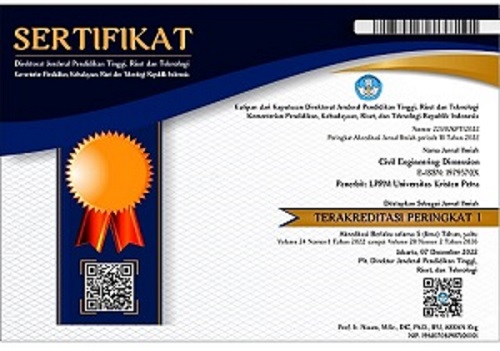A Study of Compressive Strength Characteristics of Laterite Sand Hollow Blocks
 :
:
https://doi.org/10.9744/ced.9.1.pp.%2015-18
Keywords:
compressive strength, laterite, sand, blocks, sandcrete.Abstract
This paper presents the results of experimental investigations carried out on partial replacement of sand with laterite as it affects the compressive strength of sandcrete hollow blocks. Two mix proportions (1:6 and 1:8) were used with laterite content varying between 0 and 50% at 10% intervals. Hand and machine compaction methods were used. Curing was done by sprinkling water on the specimens. The results showed that for each mix proportion and compaction method, the compressive strength decreases with increase in laterite content. Machine compacted hollow sandcrete blocks made from mix ratio 1:6 and with up to 10% laterite content is found suitable and hence recommended for building construction having attained a 28-day compressive strength of 2.07N/mm2 as required by the Nigerian Standards.Downloads
Published
2007-04-03
How to Cite
Ata, O., Olusola, K., Omojola, O., & Olanipekun, A. (2007). A Study of Compressive Strength Characteristics of Laterite Sand Hollow Blocks. Civil Engineering Dimension, 9(1), pp. 15-18. https://doi.org/10.9744/ced.9.1.pp. 15-18
Issue
Section
Articles
License
Authors who publish with this journal agree to the following terms:- Authors retain the copyright and publishing right, and grant the journal right of first publication with the work simultaneously licensed under a Creative Commons Attribution License that allows others to share the work with an acknowledgement of the work's authorship and initial publication in this journal.
- Authors are able to enter into separate, additional contractual arrangements for the non-exclusive distribution of the journal's published version of the work (e.g., post it to an institutional repository or publish it in a book), with an acknowledgement of its initial publication in this journal.
- Authors are permitted and encouraged to post their work online (e.g., in institutional repositories or on their website) followingthe publication of the article, as it can lead to productive exchanges, as well as earlier and greater citation of published work (See The Effect of Open Access).
















